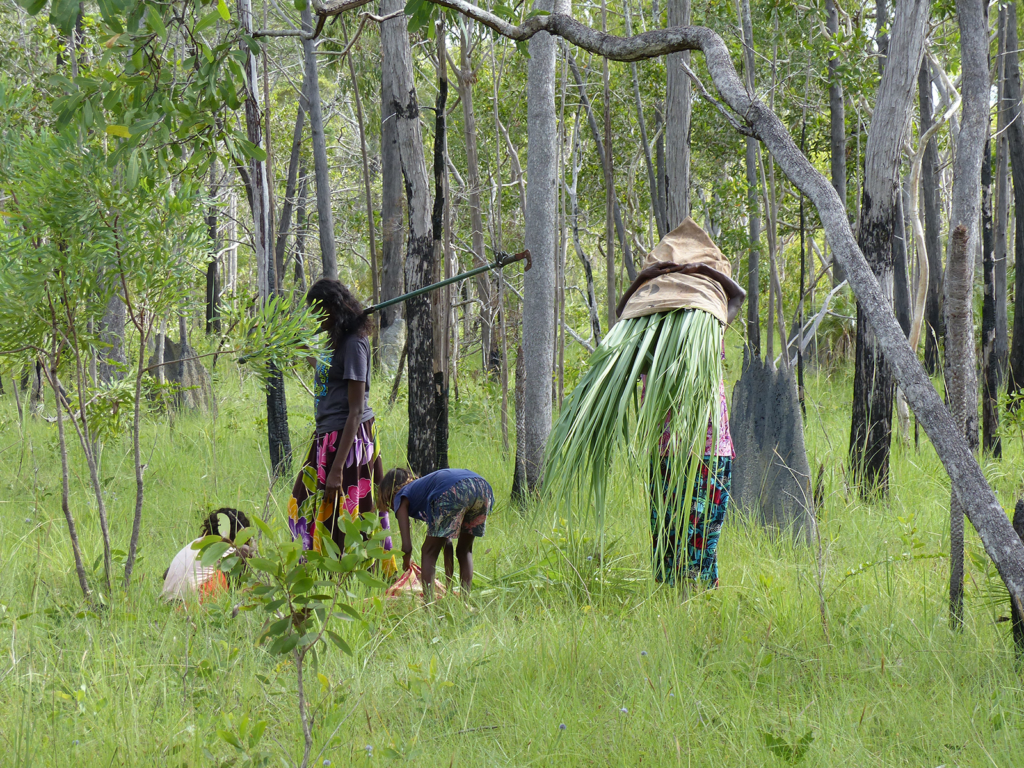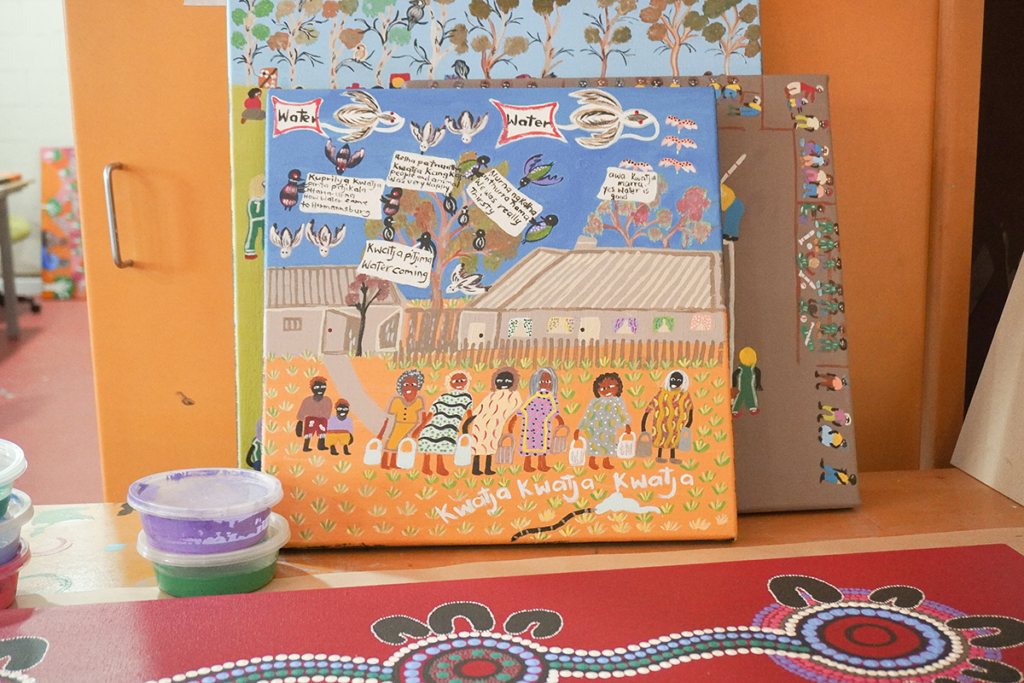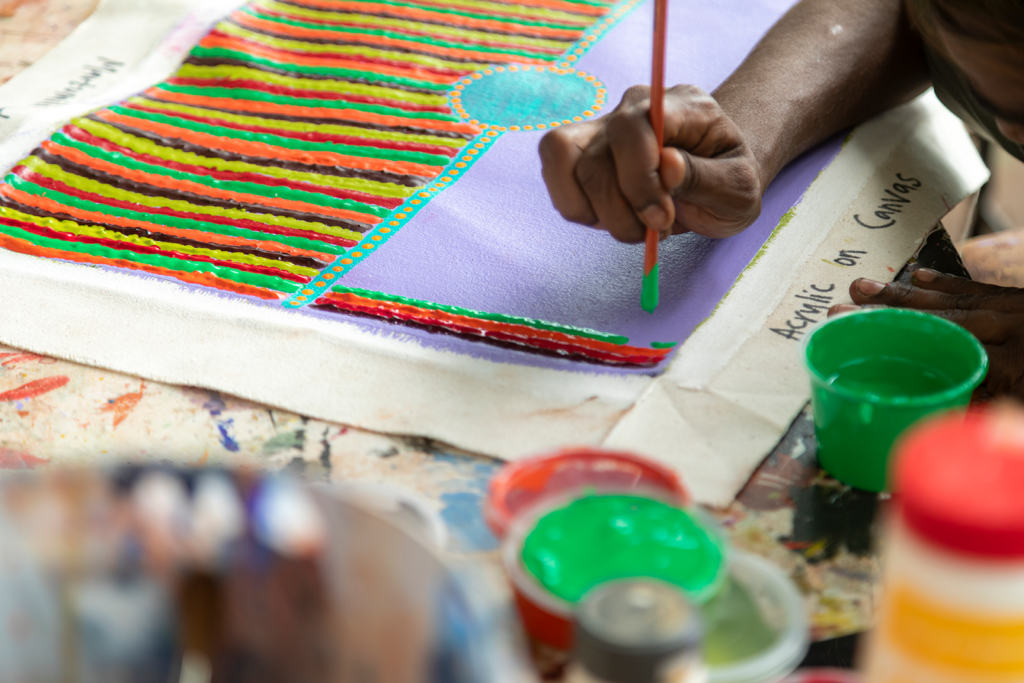Art, Culture, Country
Partnering with remote Indigenous Art Centres to deliver a landmark digital project that empowers Aboriginal and Torres Strait Islander artists to create and share unique arts and cultural experiences with the world.


Art, Culture, Country
Partnering with remote Indigenous Art Centres to deliver a landmark digital project that empowers Aboriginal and Torres Strait Islander artists to create and share unique arts and cultural experiences with the world.

Community Centred Artistry: from Arnhem Land to Bengalaru, India.

Bábbarra Women’s Centre (Maningrida) and Tharangini Studio (Bengalaru) are together redefining the boundaries of traditional artistry with their ground-breaking woodblock textile collaboration.
In 2023, senior Kuninjku artists, Janet Marawarr and Deborah Wurrkidj from Bábbarra Women’s Centre travelled to India to open their travelling exhibition ‘Jarracharra; Dry Season Wind’ at the Indian Museum in Kolkata. Whilst in India, the group visited Tharangini Studio in Sadashivanagar, Bangalore where they discovered a synergy between their respective printing methods.
‘We arrived in this country [India], we caught the plane to visit this new place. It’s totally different to where we come from. And then since we arrived here, we have been very busy looking around taking everything in – learning and observing how people are doing things here, in India. They’re really using a lot of different artistic methods printing with hand carved woodblocks applied with ink to cover the woodblock surface with ink ready for the fabric.’ – Deborah Wurrkidj, 2023.
With the support of Bawinanga Aboriginal Corporation and the Centre for Australia-India Relations, three emerging Bábbarra artists will now travel to India in September 2024 to participate in a collaborative woodblock workshop at Tharangini Studio. The group of artists, including four local Indian designers, will learn and co-create textiles using woodblock and organic dyes to further their exploration of woodblock printing and convert some of their ancestral lino designs into teak.
Padmini Govind, owner of Tharangini Studio explains that her vision is to ‘keep traditional woodblock printing relevant among the current generation’ via collaborations and workshops. To produce dye for woodblock printing, Tharangini uses organic ingredients like turmeric for yellow and Indian madder for red. The artisans stone ground them as metal grinders react with the dye and change the colour.

The yellow turmeric colour speaks to the traditional bush dyes used by pandanus weavers in the West Arnhem region. Man-kurdudjumuk – yellow colour comes from the root of the man-kurdudjumuk plant (coelospermum reticulatum) which is harvested from the sandy country near the flood plains.
Apart from traditional woodblock printing, Tharangini Studio also undertake discharge printing where the pattern is formed by removing the dye from a dark fabric.
“Nowadays industries use chemicals to discharge the dye, but we retain the traditional organic means by using a natural resin such as gum Arabic.” – Padmini Govind
Bábbarra Women’s Centre, founded by Ndjébbana leader Helen Williams in 1987, stands as a testament to the transformative journey from a humble women’s refuge and creche to a thriving textile hub. It is operated by the 40-year-old Aboriginal owned Bawinanga Aboriginal Corporation which generates economic opportunities for the regions’ clan groups to live on their Homelands. The Centre is not just a custodian of indigenous heritage; it’s a living, breathing studio where ancestral designs are printed on fabric to generate income for the designer and printer. Ancestral stories, also called Djang (Ancestoral Dreaming) or Wangarr (Dreaming) serve as a crucial connection between families and their ancestral Homelands carrying geographical, familial, and spiritual knowledge.
Designs created at Bábbarra Women’s Centre are applied in contemporary fashion, homewares as well as exhibited internationally. Bábbarra Women’s Centre predominantly uses the technique of linocut on fabric, screen print and silk bush dye. The lino printing, which utilises linoleum sheets to hand press motifs on fabric commenced in the early 2000’s when Jayne Nankivell was engaged to teach lino printing techniques as a means of economic empowerment with the early designs made into skirts and dresses. Today the favoured lino printing method continues and is passed down from generation to generation of women artists.
The Maningrida Studio is subject to monsoonal weather and extreme heat making it difficult to store decades of linoleum sheets. Even with the advent of a synthetic lino the sheets succumb to wear and tear. The lino tiles selected by the artists include stories that represent all of the language groups working at the Centre including Ndjebbana, Kuninjku, Burarra, Kune and Gur-goni.
‘The ability to preserve the lino tiles designed by generations of women leaders in Maningrida by carving the designs into teak is exciting. We have uncovered a cracked kunngol (clouds) design by Helen Lanyinwanga (dec) that will be made into wood.” – Bábbarra manager, Jessica Stalenberg.

Lanyinwanga was the mother of Deborah Wurrkidj (pictured above) and the grandmother of Abigail Gurawiliwili. Deborah travelled to India in 2023, and Abigail will travel later this year for her first experience abroad, hence ensuring that knowledge and experience is passed on from one generation to the next.
The collaborative exhibition resulting from this unique partnership between Bábbarra Women’s Centre and Tharangini Studio will take place at the Bangalore international Centre (BIC) from the 4th to 20th of October, 2024.
Bábbarra Women’s Centre would like to acknowledge the work and words of studio manager Jessica Stalenberg for her significant contribution to this article.
UPLANDS is an immersive digital project that has been designed to celebrate Indigenous Art Centres and share Aboriginal and Torres Strait Islander artistic and cultural practices with the world.
This large scale immersive digital mapping project features over twenty remote Indigenous Art Centres, and interviews with over 150 Indigenous artists and arts workers from across the country.
UPLANDS is a project by Agency and has been funded by the Australian Government through the Restart to Invest, Sustain and Expand (RISE) program and the Indigenous Visual Art Industry Support (IVAIS) program.
Government Partners


Acknowledgement of Country
We acknowledge the Traditional Owners and Sovereign Custodians of the land on which we live and work. We extend our respects to their Ancestors and all First Nations peoples and Elders past, present, and future.


















































